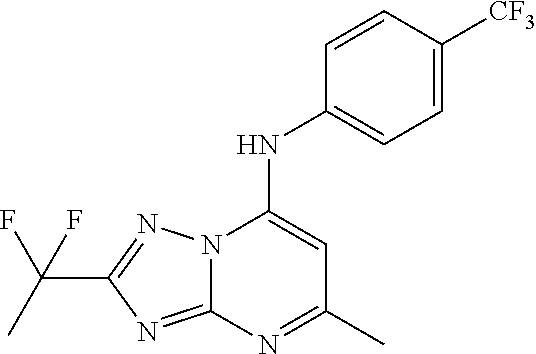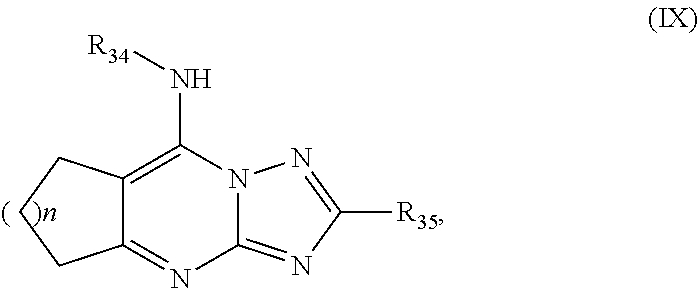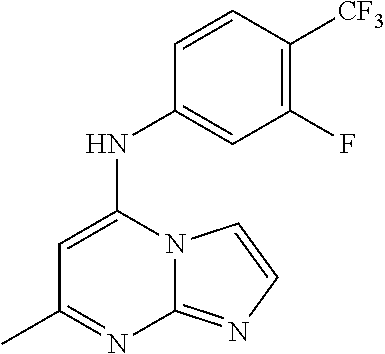Antimalarial agents that are inhibitors of dihydroorotate dehydrogenase
a technology of dihydroorotate dehydrogenase and antimalarial agents, which is applied in the direction of antiparasitic agents, drug compositions, group 3/13 element organic compounds, etc., can solve the problems of clinical symptoms, risk of contracting disease in travelers to endemic regions, and rupture and subsequent reinfection of other red blood cells
- Summary
- Abstract
- Description
- Claims
- Application Information
AI Technical Summary
Benefits of technology
Problems solved by technology
Method used
Image
Examples
example 1
Synthesis of 2,3-diamino-6-methyl-4(3H)-pyrimidinone (Intermediate 1)
[0080]To a stirring solution of NaOEt prepared from sodium (FLUKA, 9.19 g, 400 mmol) and ethanol (350 mL) was added aminoguanidine hydrochloride (ALDRICH, 44.2 g, 400 mmol). The reaction mixture was heated at 50° C. for 30 min. Then, the mixture was filtered to remove NaCl, and ethyl 3-oxobutanoate (ALDRICH, 25.3 mL, 200 mmol) was added to the filtrate. The reaction mixture was heated under reflux for 5 h and, then, stirred at room temperature overnight. The precipitate obtained was filtered and dried under vacuum to afford Intermediate 1 as a pale pink solid.
[0081]
[0082]1H NMR (400 MHz, DMSO-d6) δ ppm: 7.02 (bs, 2H), 5.51 (s, 1H), 5.29 (s, 2H), 1.98 (s, 3H); [ES+MS] m / z 141 (MH)+.
example 2
Synthesis of 2-(1,1-difluoroethyl)-5-methyl[1,2,4]triazolo[1,5-a]pyrimidin-7-ol (Intermediate 2)
[0083]Intermediate 1 was added to a stirring solution of NaOEt prepared from sodium (FLUKA, 3.28 g, 143 mmol) and ethanol (150 ml) and the mixture was heated at 80° C. for 30 minutes. The reaction mixture was cooled down to room temperature and ethyl 2,2-difluoropropanoate (FLUOROCHEM, 11.83 g, 86 mmol) was added. The mixture was stirred at room temperature for 30 min before being heated to 80° C. for 1.5 h. The reaction mixture was concentrated to dryness and water (200 mL) was added. The reaction mixture pH was adjusted to 4 by addition of 2N HCl solution while a white solid precipitated. The solid was filtered, washed with water and dried under vacuum to afford Intermediate 2. The mother liquors were extracted with DCM (5×35 mL) and the combined organic layers were dried over Na2SO4, filtered, and concentrated under vacuum to give more Intermediate 2 as a white solid.
[0084]
[0085]1H NMR...
example 3
Synthesis of 7-chloro-2-(1,1-difluoroethyl)-5-methyl[1,2,4]triazolo[1,5-a]pyrimidine (Intermediate 3)
[0086]This intermediate was synthesized by suspending Intermediate 2 in phosphorus oxychloride (ALDRICH, 21.98 ml, 236 mmol) was heating the mixture under reflux for 2 h, the starting material dissolved meanwhile. An aliquot of the reaction was partitioned between NaCO3 10% aq. (1 mL) and DCM (1 mL) and the organic phase was checked by TLC (Hexane / AcOEt 6 / 4) showing the reaction was complete. The reaction mixture was slowly added to a mixture of water and ice. The solution was neutralized with 10% aq. Na2CO3 (800 mL approx.) and product was extracted with DCM (250 mL). The aqueous layer was further extracted with DCM (2×150 mL) and the combined organic layers were washed with water (200 mL), then with brine (200 mL) and dried over MgSO4. Solvent was removed under reduced pressure. The crude product was purified (silica gel column, eluting with Hexane / AcOEt mixtures from 100:0 to 50:5...
PUM
| Property | Measurement | Unit |
|---|---|---|
| temperature | aaaaa | aaaaa |
| temperature | aaaaa | aaaaa |
| temperature | aaaaa | aaaaa |
Abstract
Description
Claims
Application Information
 Login to View More
Login to View More - R&D
- Intellectual Property
- Life Sciences
- Materials
- Tech Scout
- Unparalleled Data Quality
- Higher Quality Content
- 60% Fewer Hallucinations
Browse by: Latest US Patents, China's latest patents, Technical Efficacy Thesaurus, Application Domain, Technology Topic, Popular Technical Reports.
© 2025 PatSnap. All rights reserved.Legal|Privacy policy|Modern Slavery Act Transparency Statement|Sitemap|About US| Contact US: help@patsnap.com



